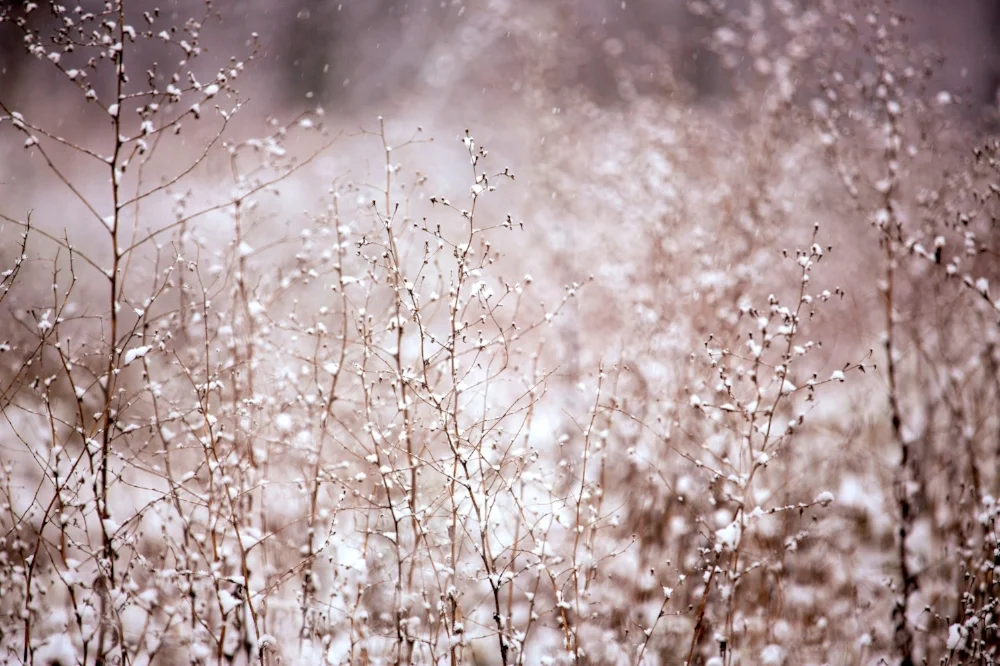Pollinators are critically important to our ecosystem. They facilitate plant reproduction and are responsible for supporting the majority of our food sources. According to the Pollinator Partnership, a third of food we eat is thanks to a pollinator. Currently, their numbers are declining due to numerous reasons including loss of habitat.
We see them busy at work during the warm months, but where do the pollinators go in the winter?
Honeybees
Even though you may never see them, bees stay where they are through the cold of winter. Each species survives by using different strategies. Honeybees join together to create a “winter colony” near the bottom of their hives. Individually, bees are ectothermic, meaning they get their body heat from external sources, but when gathered as a colony they become endothermic, creating their body heat from within.
When temperatures drop to 54-57°F outside, the drone (male) bees die off and the worker (female) bees huddle inside the hive. Their only purpose is to keep the queen bee alive over the winter by maintaining the hive’s temperature. To do this, they create a tightly compact cluster with the queen at the center and produce a shivering motion by contracting their flight muscles. The bees in the core of the colony have an average body temperature of 80°F, whereas those that make up the mantle layer, or outside of the cluster, maintain temperatures from 48-57°F. The cluster expands and contracts along with the fluctuating temperatures outside, and they rotate positions so no bee gets too cold.
During the cold season, bees feed on stored honey to fuel their energy and colonies have been known to consume up to 60 pounds of honey, depending on colony numbers and winter conditions. On warmer days (above 50°F) they leave the hive to relieve themselves as they do not produce waste inside the hive. When spring comes around again, the queen, who was previously fertilized before winter, begins her new colony.
Butterflies
Unlike bees, some butterflies migrate south for winter to keep warm. Butterflies are unable to fly when temperatures drop below 60°F, therefore, they avoid the cold northern winters. The monarch butterfly is known for one of the greatest migrations and travels up to 3,000 miles to the highlands of Mexico for overwintering. The winter monarchs travel by the masses to the same location every year, but the summer monarchs have shorter life spans taking up to 3 or 4 generations to travel back north for the summer. Even so, each generation has the natural instinct to continue the migration and have even been recorded returning back to the exact same tree as previous generations.
Different species may migrate to other warm destinations for wintering, but some take on the cold winters here with us. Hibernation has been recorded in each of the four stages of a butterfly's life cycle including eggs, caterpillars, chrysalises, or adults. Eggs are laid on the debris covering the ground where they stay throughout the season, where as caterpillars burrow at the base of their host plant when fall approaches. Some create their chrysalis just in time to protect them from the cold, and adults find a cozy spot inside crevices of logs or the bark on trees to enter a dormant phase. As cold-blooded animals, their body temperatures may drop below zero, but a chemical called glycerol acts as antifreeze allowing them to emerge again when the warm spring sun hits.
Bats
Bats also hibernate in North America over the winter. While North American bats are not pollinators (pollinator bats live in more tropical areas), they are crucial to helping our pollinators! North American bats live off of eating insects, which allows us to use less pesticides on our crops, and subsequently sparing bees and butterflies from being exposed to these toxic chemicals.
Some bats hibernate and may choose to migrate south, but those in the most northern parts of the country and mid-latitudes hibernate. As insectivores, their food source depletes as the cold approaches, so they must use the warmer seasons to gorge themselves, which will create fat reserves to last over the winter.
Bats are among few true hibernators meaning their body goes through drastic changes allowing it to practically shut down and yet survive, unlike the commonly mistaken bears who only enter torpor, a state not quite as severe as hibernation. Bats’ heartbeat shifts from 400 beats per minute to only 25 on average. They drop their body temperature to as low as just one or two degrees, and lower their metabolic rate to allow their build up fat reserves to last the five to eight month hibernation.
A common misconception about hibernation is that the animal is dormant for the entire cold season, however bats will wake up during hibernation to relieve waste or move to different parts of the cave based on the fluctuating temperature. It can take up to an hour and a lot of precious energy for the bat to become fully awake. Bats are quite particular when selecting which caves they hibernate in, choosing very complex architectural systems that keep the caves at stable temperatures between 32° to 49°F. These locations are called roosts. Other species may choose to roost in the hollows of trees. However, it is common for the big brown bat to find its way into your home for winter.
How you can help Pollinators survive the winter
With native pollinator population numbers in danger, here are some actions you can take to assist them in surviving the winter:
- Leave your lawn debris at the end of autumn as many rely on it for last minute food sources or insulated shelter such as butterfly eggs.
- Keep some exposed soil in your yard or garden for the 70% of bee species that are ground nesters.
- Don’t get rid of that dead log quite yet, as the pollinators discussed above, along with others, may rely on it for overwintering.
- Plant pollinator-friendly plants to provide pollinators with the nutrients they need or assist them during migration, such as milkweed for monarchs.
- If you find that bats have roosted in your home during winter, do not disturb them. Doing so expends as much energy as they normally would normally over the span of two to three weeks. Don’t cover entry points, which will only trap them inside. Instead, wait until spring when you are sure they have left before you patch up entry points. Consider hiring professionals, who can help you find other possible entry points that you don't know about.
- Install bat homes outside providing them another shelter option.
Next time you brave the cold outdoors, remember that even though they often go unseen, pollinators are still among us!
Show your support for Wild Paws' mission of rescuing and providing a safe habitat for wild animals using sustainable resources, promoting coexistence between humans and wildlife, and educating the public about the preservation of wild animals and their ecosystems.





